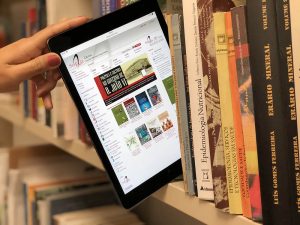By Ernesto Spinak
Introduction
The SciELO Program celebrates 20 years of activity in full process of alignment with the advances of Open Science. For this reason, on September 24th and 25th, eight specialized working groups (WG) have been organized. WG8 will analyze one of the classic types of scientific literature – the academic book.
As stated in the presentation of WG8, “Although present in all areas of knowledge, its relevance in research communication is highlighted with more emphasis in the areas of social sciences, literature, and arts. […] The scope of this working group is to analyze the relevance of the academic book in research communication, the current state and trends of online publication and indexing of academic books in the SciELO Network countries and the challenges for adopting standards that maximize their visibility, use and impact”1. The following reflections are published with the objective of promoting an open debate among all participants and readers of SciELO in Perspective and encouraging them to contribute with their opinions. At the end of this post, there will be instructions on how to participate.
The WG8 starts with a supporting selected bibliography2, which served as the basis for writing this post.
A brief history of the academic book
In ancient times, scientific ideas were gathered in manuscripts which were then compiled as books by philosophers such as Aristotle, Ptolemy, Euclid, Galen, and many others.
These manuscripts, through Arab civilization, were preserved and transmitted until they reappeared in Europe at the end of the Middle Ages, when the first universities were created: University of Bologna, Italy (1088), University of Oxford, UK (1096), University of Salamanca, Spain (1218), University of Padua, Italy (1222), and a long etcetera.
The proliferation of university courses created a demand for books, and by the middle of the fifteenth century, thanks to the invention of movable types by Gutenberg, the book production system was transformed, facilitating scholarly communication in durable and economical media. As a consequence of this new technology, the process of storing, disseminating and retrieving information was revolutionized.
From ancient Greeks to the Renaissance, books were the primary means of preserving and disseminating science. It has also been a constant that, throughout history, new technologies have always contributed to expand the access to information, responding to new needs and opening new paths.
By the middle of the seventeenth century, epistolary exchange became the most widely used mechanism for communicating peer-to-peer research results, as Copernicus, Galileo, Kepler, and many others used this medium. It was then that incipient scientific societies, such as the Royal Society of London, began to sponsor this medium of information exchange and to announce discoveries. The formalization of these correspondence procedures resulted in the birth of the first two scientific journals in the world: the Journal des Sçavans (Paris), in January 1665, and three months later, the Philosophical Transactions of the Royal Society of London.
These journals, followed by many others later on, constructed the memory of science and the dissemination of results. They were appropriate communication tools because they fulfilled the following functions:
- Provide answers to questions;
- Contribute to professional updating;
- Encourage the discovery and understanding of new fields of interest;
- Disclose emerging trends;
- Check the reliability of new knowledge;
- Expand the interests of scientists;
- Help perfect scientists.
The journals, along with the books, covered most of these needs throughout the centuries of the Modern Age and the beginnings of the Contemporary Age, until after World War II, when the world changed. In all its aspects, including the way of perceiving and communicating science.
It was in the 1960s that analyses by William Garvey and Berver Griffiith described a general model of the flow of scientific information in the various areas of knowledge. According to this model, scholarly communication goes through several intermediate stages, starting with preliminary reports, then meetings in scientific events, publication in annals of congresses, sometimes preprints, to finally be published in the formal media.
With the emergence of electronic media at the end of the last century, a new culture is generated, fostered by digital technologies and networks, with a great flowering of informal communications among scientist peers. It is here, then, in the informal networks, where the major changes in communication between scientists took place.
The ascendancy of the Internet has profoundly impacted the scientific environment as a powerful medium of communication and has allowed scientific output to expand its reach from online journals and e-books to repositories, blogs, and digital libraries as a means of faster science dissemination, and that are presented as successful models of popularization of science and technology oriented themes, increasingly expanding the circulation of information, first among peers and then to the general public.
This hyperlinked system that allows for continuous feedback clearly underlines one of science’s characteristics, which is that scientific knowledge is temporary, constantly revising itself, and that, as a result, increases the collective memory of both formal and informal media.
The knowledge cycle acquires a new way of sharing information of data production/collection and the production of texts in a cooperative way until its formal publication.
Since its earliest start, almost a thousand years ago, universities have been key actors in scholarly communication, whether by publishing scholarly journals or by publishing books. In particular, the production of books by university publishers goes beyond the mission of disseminating a product and the socialization of knowledge. In the editing process, the university incorporates aesthetic, academic and social values in its books, thanks to its undergoing of an evaluation process through an editorial board. This is an important added value offered by books produced by academic institutions.
This is why the question is pertinent: are university book publishers aligned with the new way of producing science? We refer to Open Science, Data Management, the availability of preprints repositories, the definition of policies for data reuse, transparency, and acceleration in the dissemination of results.
Let us think whether university publishers are publishing their books under policies that reflect the emerging model of science dissemination with the following characteristics:
- Share data in all stages of research, with the collaboration of scientists;
- Disseminate the information that is published in books also online through blogs, social networks, wikis, etc.;
- Publish books under different copyright licenses, such as Creative Commons licenses, or organize them in the public domain, etc.
What do academic books require in order to upgrade to the digital world and Open Science?
Let us pause to reflect on the forms of scholarly communication that universities do, whether in journals or through books:
- Each discipline has a different publication model;
- The natural sciences require a dynamic and concise model, which is why they mainly use journals;
- The social and humane sciences preferentially publish in books because they need a more extensive textual presentation;
- Also, at the time of publication, the criteria of funding agencies and the institutions the researchers are linked to matter.
Journals have become more prestigious channels than books regarding evaluation in the scientific reward systems because, unlike with journals, some evaluation standards (visibility, impact, citations) have not been sufficiently adopted and adapted to the editorial world of books. This is a disadvantage and it should be addressed.
What methodologies and technologies should incorporated to the university’s book publishing system in order to shorten the distance to the academic journals’ world? How can university book publishers align with open science?
It is an immediate need to promote university book publishers who incorporate international standards of production, such as the following:
- Information interoperability between databases;
- Interoperability of books in the flow of scholarly communication;
- Reformulation of the business model to include the publication of books in electronic media, under new author licenses;
- Creation of strategies to expand its dissemination;
- Promote and facilitate the indexing of full texts, whose importance is reflected in the increased use and impact of citations;
- Adopt the use of persistent identifiers for books and their authors (DOI, ISNI, ORCID, etc.).
How to participate in this open forum?
This is only a basic and preliminary list, certainly incomplete, but the subject matter is very important for SciELO Books Network, because “the vast majority of universities and research and development institutes and a minority of scientific societies and professional associations in the SciELO Network countries operate publishers that, in addition to textbooks and popular science books, publish works that communicate research results. At the same time, the national systems of scientific output evaluation rely on books assessment systems or methodologies complementing those of journals. On a smaller scale than journals’, the publication of scholarly books is also an integral part of research infrastructures”1.
You are invited to participate and cooperate with the celebration of SciELO 20 Years through comments, testimonials, posts, articles, etc., related to the topic of this working group, whose page can be accessed by going to <https://www.scielo20.org/redescielo/grupos-de-trabalho/gt8>.
Notes
1. WG8 – Relevance of Academic Books in Research Communication [online]. SciELO 20 Years. 2018 [viewed 07 August 2018]. Available from: https://www.scielo20.org/redescielo/en/working-groups/wg8/#1521832077831-c8dae681-e2a4
2. The documents published in the Working Group 8 of the SciELO Network Meeting of the SciELO 20 Years Week were used as the basis for this post:
- DARNTON, R. A questão dos livros: passado, presente e futuro. São Paulo: Companhia das Letras, 2010. Available from: http://seer.ufrgs.br/aedos/article/viewFile/16873/11954
- RONCAGLIA, G. La cuarta revolución: seis lecciones sobre el futuro del libro. Bogotá: Ediciones Uniandes; Vila María: Eduvim, 2015.
- ROSA, F.G.M.G. and BARROS, S. Comunicação científica: reflexões preliminares para o GT “Relevância dos livros acadêmicos na comunicação da pesquisa” [online]. SciELO 20 Anos. 2018 [viewed 07 August 2018]. Available from: https://www.scielo20.org/redescielo/wp-content/uploads/sites/2/2018/07/ROSA-F_-BARROSS.-Comunicacao-Cientifica.pdf
References
DARNTON, R. A questão dos livros: passado, presente e futuro. São Paulo: Companhia das Letras, 2010. Available from: http://seer.ufrgs.br/aedos/article/viewFile/16873/11954
WG8 – Relevance of Academic Books in Research Communication [online]. SciELO 20 Years. 2018 [viewed 07 August 2018]. Available from: https://www.scielo20.org/redescielo/en/working-groups/wg8/#1521832077831-c8dae681-e2a4
RONCAGLIA, G. La cuarta revolución: seis lecciones sobre el futuro del libro. Bogotá: Ediciones Uniandes; Vila María: Eduvim, 2015.
ROSA, F.G.M.G. and BARROS, S. Comunicação científica: reflexões preliminares para o GT “Relevância dos livros acadêmicos na comunicação da pesquisa” [online]. SciELO 20 Anos. 2018 [viewed 07 August 2018]. Available from: https://www.scielo20.org/redescielo/wp-content/uploads/sites/2/2018/07/ROSA-F_-BARROSS.-Comunicacao-Cientifica.pdf
External link
WG8 – Relevance of Academic Books in Research Communication <https://www.scielo20.org/redescielo/en/working-groups/wg8>
About Ernesto Spinak
Collaborator on the SciELO program, a Systems Engineer with a Bachelor’s degree in Library Science, and a Diploma of Advanced Studies from the Universitat Oberta de Catalunya (Barcelona, Spain) and a Master’s in “Sociedad de la Información” (Information Society) from the same university. Currently has a consulting company that provides services in information projects to 14 government institutions and universities in Uruguay.
Translated from the original in Spanish by Lilian Nassi-Calò.
Como citar este post [ISO 690/2010]:

















In ancient times, scientific ideas were gathered in manuscripts which were then compiled as books by philosophers such as Aristotle